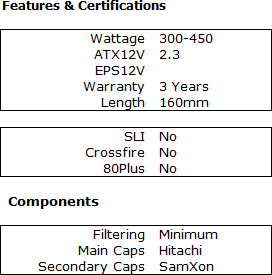Thermaltake TR2 QFan Series
by Christoph Katzer on November 19, 2008 3:00 AM EST- Posted in
- Cases/Cooling/PSUs
 |
Conclusion
The first time we saw the TR2 QFan on the show floor, we were extremely happy to see that someone was still planning to offer a good PSU targeting users that need less than 500W. The four power supplies we've tested today perform very well and we have no problem recommending them to anyone putting together a moderate PC. All we need now is retail availability.
In terms of features and performance, the QFan marketing sounds nice but we didn't see any actual benefit in testing. Thermaltake also cut corners in other areas to keep costs down; some of the cost cutting measures will matter, but others are trivial. Packaging for example uses the same simple box for all of the units, with the only difference being the large paper wrap that lists the wattage. All of the cables and connectors on the various units are also identical, as the bigger concern.
The connectors are a little limited on all of the units, with a maximum configuration being a GPU that requires two 6-pin PEG connectors. The 12V rail is also a concern, but typical midrange graphics cards should run fine even on the smallest 300W unit. There are also sufficient Molex and SATA connectors on hand for most users looking at this range of power supply.
DC regulation is average with around 5% on all rails. The 3.3V rail differs among the four units we tested, but the other rails are all similar. The efficiency ratings are great for lower output PSUs, and all of the units reach 85% to 86% maximum efficiency with 230VAC. That will be a great selling point for these units and we hope that more people will actually pay attention to these results.
As for the fan speed and the resulting acoustical noise, we can say that the fan control works well; with increasing temperatures, the fan spins faster. We just don't see the sense in advertising a promising feature like the QFan that actually doesn't seem to add much to the package. The temperature of the first two heatsinks stays below 40°C, but the secondary heatsink temperature reaches 80°C, which is not very good. As mentioned earlier, a larger heatsink should perform a little better.
With all of the power supply companies heavily marketing their high-end, high capacity PSU models, it's difficult to gauge how much interest there will be in good quality 300W to 500W PSUs. Even Thermaltake doesn't appear to be very bullish on the subject, as we first heard about the TR2 series over eight months ago.
 |
Even after all this time, these units are still not available on retail shelves, so we don't know what prices will be. We can only hope that Thermaltake will manage to offer these power supplies at a reasonable price, so that more users will end up purchasing something appropriate to their needs. Not only does it cost more money to purchase a 600W-1000W PSU, but if you aren't routinely drawing 300W+ of power such large PSUs end up being less efficient. If all you need is a single 6-pin PEG connector for your graphics card, and you don't plan to heavily overclock your system, the Thermaltake TR2 QFan series of power supplies should be near the top of your shopping list.










36 Comments
View All Comments
Slomo4shO - Wednesday, November 19, 2008 - link
Would it be possible to include CORSAIR CMPSU-400CX, PC Power & Cooling Silencer PPCS420X, OCZ ModXStream Pro OCZ400MXSP, and OCZ ModXStream Pro OCZ500MXSP in your upcoming write-up?Christoph Katzer - Wednesday, November 19, 2008 - link
Yep, have them already here.Havor - Thursday, November 20, 2008 - link
Hi Christoph nice reviewBut if you really be cool if you would put all the tested PSU's in a database.
ware you can select a power rating (like say 400~450W) and see on a graf how all the PSUs performs in that W-rating
http://img03.picoodle.com/img/img03/3/11/20/f_PSUg...">http://img03.picoodle.com/img/img03/3/11/20/f_PSUg...
A other thing that would be nice would be if you would give all PSU a grade from 0~100 ware 100 would be a PSU perfect PSU <15db/100% eff./DC output perfect flat/temp <30c/PFC = 1/build quality perfect
And then turn it in a graf. and cross it whit personal most important part for HTPC builders that would be db, for people building a server it would be high % efficacy
Mr Perfect - Wednesday, November 19, 2008 - link
It would be interesting to know what Seasonic is up to these days. Their old S12 line was quite impressive in it's day.Oh, and anything that has more then just one 6pin PEG connector. Someone with a reasonably powered system might still want to hook in a 4870 or GTX260, seeing how games are generally GPU limited today.
Netcraazzy - Wednesday, November 19, 2008 - link
I'd love to see a head-to-head comparison between these PSUs and similar units from Antec, OCZ, Seasonic, Sparkle and others. I'm especially interested in the 400w-500w range.Amart - Wednesday, November 19, 2008 - link
Opinion seconded, well done with the review. I especially appreciate the attention to quality and ripple graphs, as these are of prime concern when recommending a PSU.